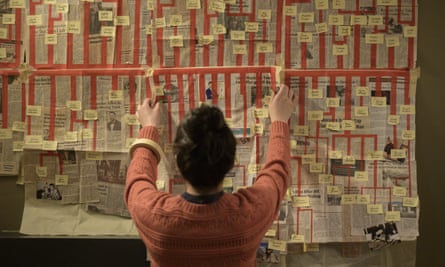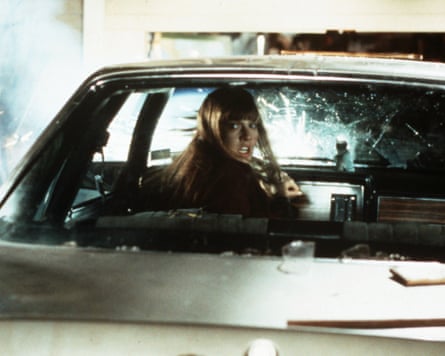‘My inbox is filled with the most horrible ways people can die,” says Craig Perry, the producer – or, as he would prefer, “curator” – of the Final Destination franchise. Over 25 years, his films have punctured, skewered, crushed, flattened and decapitated men, women and children in a series of horrifying “accidents” and Perry has been a witness to them all. His friends clearly want him to witness many more.
But as we speak on video call, just a few weeks before the sixth instalment is released, he seems far from traumatised. Instead, he’s ebullient, buzzing infectiously about the many gory deaths he has overseen with the same enthusiasm other people might display when talking about their children (“If you’re not having fun, don’t do it!” he grins). He has every right to be proud. To date, the films have made more than $657m (£493m) worldwide and helped to terrify a generation of millennials about the dangers that arise not from entering a haunted house or swimming in shark-infested waters but from the mundanities of taking a shower or driving your car. In the Final Destination movies, death is everywhere.
In the first film, released in the spring of 2000, it was on a plane and a teen, experiencing a gruesome premonition, sniffed it out early, saving himself and a handful of others as it exploded in front of them. But death soon followed them all home and constructed shocking, often grimly amusing, Rube Goldberg-style death sequences for them, correcting the imbalance. Sequels inevitably followed, kicking off with mayhem on the road, a rollercoaster, a racetrack and a suspension bridge.
The original iteration of the script, once intended to be an X-Files episode, had personified death. But “using inanimate objects to achieve its objective” is something Perry believes has given the series its staying power.
“It allows the audience to bring whatever baggage or notions that they have about death,” he tells me. “It could be cultural or personal or that moment two years ago when they had a near miss and thought, man, if I just stepped right or left, that would have been the end of it. You bring all that to the movie and it makes it yours. Your experience is unique to you.”

In the latest film, Final Destination: Bloodlines, the formula sees a slight shake-up. The film opens in the 1960s; the premonition-haver has found a way to cheat death for decades until the collapse of a space-needle restaurant that leads to the destruction of a whole family (instead of, as in earlier films, a group of teens or strangers). It was the brainchild of Spider-Man director Jon Watts, who then enlisted directing duo Adam Stein and Zach Lipovsky to breathe new life into a franchise that had been dormant for 14 years.
The new film arrives at a time filled with nostalgia horror plays. The seventh chapter of the rebooted Scream franchise has just finished production, a rehaul of I Know What You Did Last Summer starring is out this July and an Urban Legend remake was announced last week. But masked slashers aside, is a new generation ready to be scared of, well, everything? Aren’t they scared enough? Turns out, not nearly.
“What are the everyday experiences or everyday objects or everyday feelings that we can ruin for people?” asks Stein, speaking to me with his co-director on a break during the production of Freaks Underground, a sequel to their acclaimed 2018 breakout Freaks. No spoilers but as the trailers already suggest, this time prepare to be terrified of tattoo parlours, family barbecues, revolving doors and glass elevators.
Inspiration comes to Perry not only via email, but to the entire creative team via the anxieties of everyday life – what if that fell, what if I fell, what if that fell while I was falling etc. “It’s those things that you run into in your daily life all the time and you just feel a little bit off about,” Lipovsky says (hint for the new film: his apartment overlooks an alley where garbage is frequently collected). Perry jokes that he “can’t walk into a room without doing a threat matrix”.
While many of the death scenes might seem cartoonishly far-fetched, it’s become surprisingly important for those involved to heavily research just how close to reality they could actually be. I mistakenly referred to a grisly scene involving a monstrously powerful magnetic resonance imaging machine, already teased at Comic-Con, as outlandish. I was corrected. Top-end MRIs, Perry tells me, “can literally pull entire gurneys into them and fold them over. That’s all true.”
Lipovsky adds that he read up on some “extremely tragic and horrible” stories in his research (think guns and wheelchairs sucked into machines). “It all has to be stuff the audience generally would believe is possible,” he says. He goes on to tell me about extravagant crew tests involving mannequins.

But how do you centre a film on the utter inescapability of death and not make it feel like a depressing slog? “It’s knowing without diminishing, if that makes sense,” Perry says. “And this is why I think it’s so hard. People don’t realise how challenging the tone is in these movies.”
Is he worried about increased sensitivities with a new generation (the first film featured a pre-9/11 plane crash and a grim shower death mistaken for a suicide)? “One of the challenges with this storytelling in general is if you have to have trigger warnings for drama, that means you can’t have an antagonist,” he says. “Because antagonists, by their very nature, do terrible things.” He adds: “I feel like if we get hamstrung by overanalysing that thing, we’re just going to have movies that play like tapioca. It’s just not going to be intriguing.”
Stein agrees that it’s “incredibly tricky” to make so much carnage so much fun but the secret is in the bad guy, death. “You kind of root for him because of his sense of humour,” he says. “He’s just so clever.”

Despite the films forcing family members or partners to watch their loved ones get brutally splattered to smithereens in front of them, the franchise isn’t really known for its humanity. Here, death doesn’t mean all that much. But in the new film, it suddenly does. Tony Todd, who has appeared in all but one of the films (including a voice role in the third one), died in November last year, not long after filming a one-scene cameo. His on-screen farewell is a surprisingly moving moment, the actor looking strikingly frail.
“Everyone involved knew he was ill and we weren’t sure at certain points whether he would be able to participate,” Stein tells me. “It was a really unique moment because talking about his own death for the movie on this meta level, he’s speaking to the fans about his death. And so in that moment when he had his final goodbye, we asked him if he would be able to kind of put the script away and do a take where he spoke from the heart about what death means and what life means … it’s his honest words of wisdom direct to you.”
It’s a rare moving moment in a film that’s otherwise as energetic and fun as the very best of the franchise. The first one turned 20 just after the pandemic kicked in and, with Bloodlines emerging as the world continues to burn in new and old ways, what purpose does a Final Destination film have in 2025?
“There’s a lot of depressing things happening in the world,” Lipovsky says, believing that the film will take viewers to “a different place outside the real world for a few hours”.
Stein adds: “The communal experience of watching this movie in a theatre is really something to behold. Twelve minutes in, when a little boy gets crushed by a falling piano, the entire audience erupts in cheers. And that is something really fun.”
Source: theguardian.com


